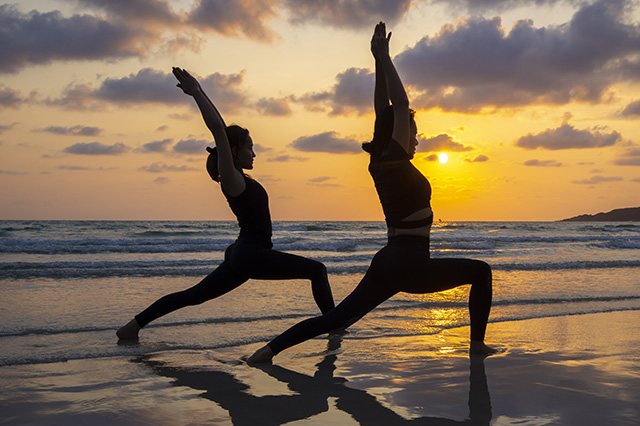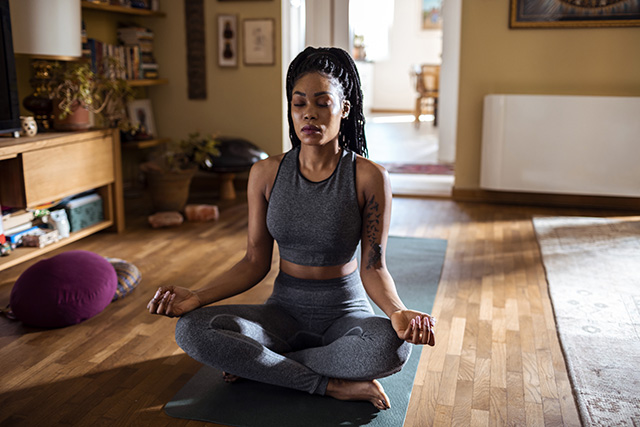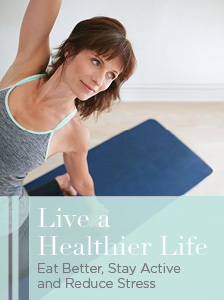Yoga is a practice that incorporates a mix of stretches, physical postures, deep-breathing exercises and relaxation techniques as a way to help improve both physical fitness and mental wellness. If you’ve never tried it before, or are simply looking to brush-up, this intro to yoga will get you acquainted with the basics and benefits.
Intro to Yoga
The practice of yoga originated in India and was first introduced to the U.S. by a Hindu monk named Swami Vivekananda in 1893. This early form of yoga was more of a philosophy, including elements of psychology and self-improvement. Yoga would continue to spread around the world and take on many forms.
“While there are more than 100 different types, or schools, of yoga, most sessions typically include breathing exercises, meditation and assuming postures (sometimes called asana or poses) that stretch and flex various muscle groups,” according to the American Osteopathic Association.
The pose-based yoga we know today gained popularity in the early 20th century. Modern forms of yoga often focus on improving mental and physical health, and some also include spiritual elements.
The Health Benefits of Yoga
Yoga boasts many benefits, including improving physical fitness, mental health and emotional well-being, according to Johns Hopkins Medicine.
Physical Benefits
Yoga helps improve your balance and flexibility all while toning and strengthening a variety of muscles. It can also help lessen chronic pain, including arthritis, carpal tunnel syndrome, lower back pain and more.
“With continued practice comes a gradual loosening of the muscles and connective tissues surrounding the bones and joints; this is thought to be one reason that yoga is associated with reduced aches and pains,” according to a study by the International Journal of Yoga.
Yoga can also improve your cardio and circulatory health. Yoga involves a lot of deep breathing, leading to improved respiration and increased blood flow.
“Yoga also thins the blood,” according to the study, “which can decrease the risk of heart attack and stroke.”
Like many other forms of exercise, routinely practicing yoga can also help you maintain a balanced metabolism and help with weight loss.
Mental/Emotional Benefits
When it comes to emotional and mental benefits, yoga can help improve your concentration as well as promote feelings of calmness and general wellbeing.
Yoga can help you feel more energetic and improve your mood. “Yoga can produce an invigorating effect on mental and physical energy that improves fitness and reduces fatigue,” according to the International Journal of Yoga study.
Yoga has also been used as a tool for coping with mental health issues, helping people achieve a more balanced mental state.
“Yoga targets unmanaged stress, a main component of chronic disorders such as anxiety, depression, obesity, diabetes and insomnia,” according to the American Psychological Association. “The practice enhances resilience and improves mind-body awareness, which can help people adjust their behaviors based on the feelings they’re experiencing in their bodies.”
Yoga can also help with stress management and alleviate some of the adverse effects stress has on the body.
“Practicing yoga and meditation as a means to manage and relieve both acute and chronic stress helps individuals overcome other co-morbidities associated with diseases and leads to increased quality of life,” according to the study. “It lowers breathing and heart rate, decreases blood pressure, lowers cortisol levels and increases blood flow to the intestines and vital organs.”
Yoga may also help you get better sleep. The same study by the International Journal of Yoga showed “regular practice of yoga resulted in a significant decrease in the time taken to fall asleep, an increase in the total number of hours slept and in the feeling of being rested in the morning.”

Types of Yoga
There are many different schools of yoga. Modern interpretations tend to place more emphasis on physical fitness, as opposed to spiritual enlightenment, but stress-relief and mindfulness are still important aspects in several forms of yoga.
To get you started on your intro to yoga, here’s a general breakdown of some of the most popular types.
- Yin/Meditative yoga – a slower paced form of yoga, where poses are held for longer.
- Vinyasa/Flow yoga – focuses on pairing breath with movement.
- Sivananda – focuses on general relaxation, using a mix of poses and breathing exercises.
- Restorative yoga – focuses on relaxing your body and mind, calming you down after a long day.
- Prenatal yoga – intended for pregnant women, helps prepare them for labor.
- Power yoga – a more physically active form of yoga, open to interpretation by individual teachers.
- Kundalini yoga – a mix of physical and spiritual wellness, focusing on unlocking energy (life force energy, prana or chi).
- Jivamukti yoga – a vinyasa-style yoga mixed with spiritual Hindu teachings, including connection to the Earth and vegetarianism.
- Iyengar yoga – focuses on alignment, often includes props (straps, blocks, chairs, etc.)
- Hot yoga – occurs in a hot, sauna-like room to help you sweat.
- Hatha yoga – focuses on balance, also an umbrella term for physical-based yoga practices.
- Ashtanga yoga – focuses on poses, where you work through a series of postures.
- Anusara yoga – focuses on the mind-body-heart connection.
- Aerial/gravity yoga – a newer practice that uses suspension/hammocks.
- Acro yoga – another new interpretation, this yoga form is done with a partner.
Trying Yoga
Yoga is accessible to beginners and experts alike, regardless of age.
When it comes to supplies, all you need is a yoga mat and comfortable clothes. If you’re new to yoga, or looking to get back into it, there are plenty of instructional videos and apps available online. Also, in-person yoga classes (especially outdoor varieties) for beginners are likely to return as more people get vaccinated. It’s helpful to learn from an in-person instructor if you’re a beginner, since they can help you with form and adjustments.
For more information about meditating , check out these meditation tips along with these meditation and mindfulness apps. Don’t have a lot of time to set aside for exercise? Try chair yoga as a way to destress at your desk.
What’s your favorite thing about yoga? Did you find this intro to yoga helpful? Tell us in the comments.

















